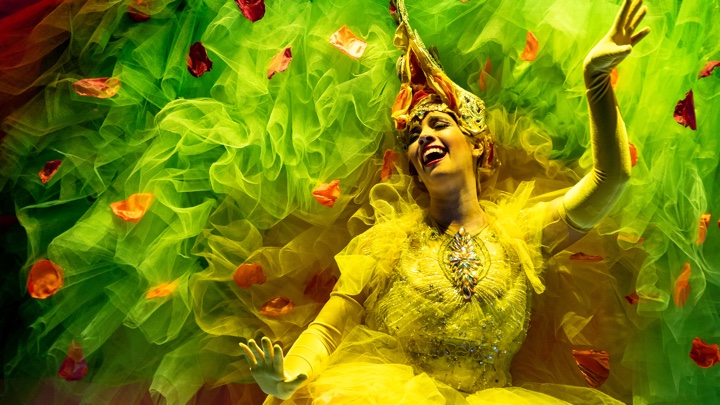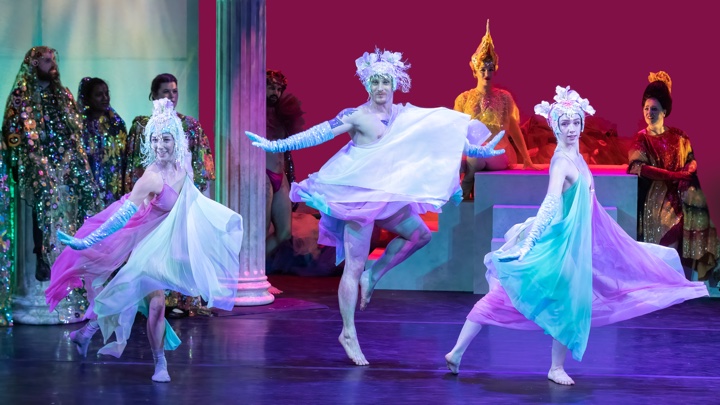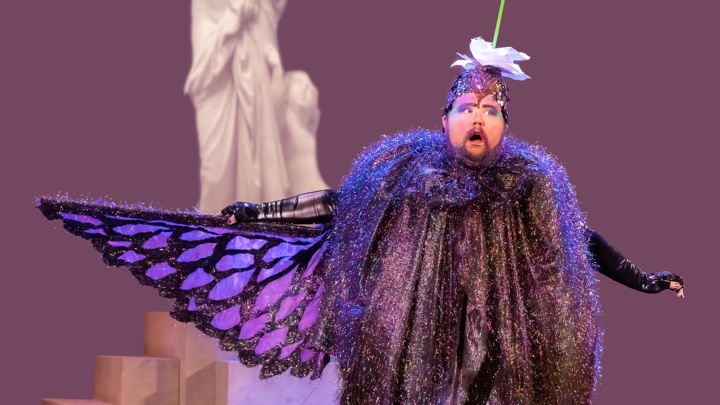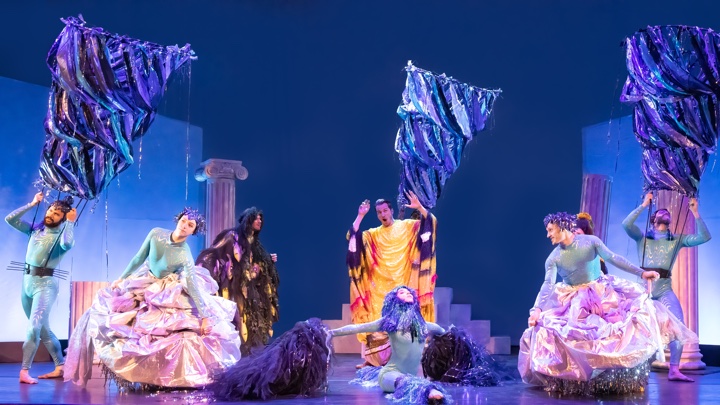

This tragic conclusion did not meet with favor in the salon of the music-loving Marquise de Pompadour and her boyfriend, Louis XV. Accordingly, Léandre et Héro, the divertissement that Pierre de la Garde concocted for them, supplies a genuine god from the machine, Neptune, who transforms the expiring lovers into mer-courtiers of his submersible realm. Everybody dance!
In French opera—until Pelleas et Mélisande anyway—there is always a great deal of dance; often, dance rather than song is the main event. Ryan Brown’s Opera Lafayette—based in D.C. but regularly bringing its shows to New York—is a stylish opera company of a prevailingly French orientation, so it could hardly produce its offerings with the proper panache if it did not partner with a dance company or two.
Last month, in a brilliant evening in the fairy tale-encrusted theater of New York’s Museo del Barrio, there were, besides singers and the Opera Lafayette Orchestra, two dance companies: the New York Baroque Dance Company, whose denizens portrayed the usual overdressed nymphs and shepherds, and the Seán Curran Company, who, in skintight teal, frolicked about the stage impersonating waves and billows, hoisting and propelling the flailing Léandre of Maxime Melnick, while, from the shore, Emmanuelle de Negri sang Héro with silvery, bell-like tones, and Douglas Williams intervened as a dignified, fathoms-deep Neptune.
The presentation had the charm of brevity, but it was only half the program. There was more substantial fare to come, the American premiere (or second performance, after the prima in D.C. last week) of Jean-Philippe Rameau’s Io. This opera, like many of Rameau’s scores, has not survived intact and may never have been completed, but a team of musicologists and musicians have pieced it together, borrowed arias and an overture from other works, composed some recitativo accompagnato themselves—and they served up a scenic opéra-comique.
This Opera Lafayette has seen fit to stage—enhanced by the Curran dancers and the spectacular costumes of an artist called Machine Dazzle. On his web site, Dazzle describes himself as “a radical queer emotionally driven, instinct-based concept artist and thinker,” and strange to say, that’s just how I was going to describe his costumes though I’d never heard of him.
There is color, there is flesh, there are odd textures and fabrics and curious appendages, and you find yourself looking at them, and looking again, because you still aren’t sure what they are intended to be. Species and gender are the least of it. Colorful and fascinating. That is what they are intended to be. (To be fair, the audience in the sold-out house last Tuesday was very nearly as gaudily turned out.)
You, of course, remember the story of Io, the Argive princess beloved by Jupiter. To save her from the jealousy of Juno, he transformed her into a cow, whereupon Juno sent a gnat that pursued Io to Egypt, where she became the goddess Isis. Well, Rameau threw all that out. No cows here and, happily, no gnats. I was expecting a cow.
Instead, we had a rivalry in love: Jupiter (Mr. Williams again, bare-chested this time) and Apollon (Mr. Melnik, in effulgent gold sun-streamers) were both pursuing Io (Ms. de Negri once more); she goes for Jupe but is understandably wary of his wife. He is happy to divide the world between heavenly and earthly realms with a bride in each—sort of a Captain’s Paradise, with superpowers. Apollon consoled himself with plump and furry Mercure (Patrick Kilbride). Everybody dance!
The dances displayed the Graces (three, in diaphanous gauze), the Pleasures (two, in next to nothing) and Games (just one, in preposterous referee black and white, with huge ball appendages in unexpected places), and they were highly athletic (Seán Curran’s company again), but then Folly showed up to sing her great aria from Rameau’s Platée in several voices and styles at once, including superdiva. She was played by Gwendoline Blondeel. While all the singers were of high quality, Blondeel was the pièce de résistance, not that she resisted much.
This led to a happy ending except for a choreographic storm, whirling and twirling spangly winds before a choral conclusion. Theatrical substance? Well, the storm blew it all away. I’d love to know what the chic Pompadour would have made of these variations on her salon themes! Though I was just as happy she—and her hair—weren’t sitting in front of me.
On Thursday, I returned to the Museo for works of Giovanni Battista Pergolesi. This composer died of tuberculosis at the age of 26; he is the shortest-lived composer generally acknowledged as being among the immortals for a melodic gift impressive even in the era of Handel, Caldara and Vivaldi. Most of his output were opere serie of the kind forgotten for nearly three hundred years after its heyday.
Today, however, such works, by a dozen of his peers, are favorites for revival—Opera Lafayette has given us works of Handel, Lully and Sacchini. But the program last Thursday focused on two of Pergolesi’s most familiar surviving pieces—familiar yet infrequently performed and, with such forces, highly welcome.
The first half of the program was the intermezzo La Serva Padrona, performed in Nick Olcott’s French translation (La servante maîtresse), semi-staged, as was appropriate. Intermezzi were comic skits performed by “character” singers during scene changes of baroque grand operas. The vocal demands are not grand, the plots are basic, spoof and character are key.
Eventually the comic spoofs extended to become full-length comic operas, and eventually (think Figaro and Cenerentola) such comedies supplanted the stale old grand operas as the reigning entertainment. Musical comedy has a similar genealogy.
Jonathan Woody, whose voice has respectable depths for the self-important Pandolfe, seemed a bit dry until he warmed to his task—the enviable one of scolding his maid, Zerbine, until she tricks him into a proposal. Hannah De Priest sang Zerbine with a most winning clarity of phrase, her comedy tinged with hints of sentiment. Their buffo goings-on (sung in French, spoken in English, in proper couplets in either case) were enhanced by the wordless fulminations of Patrick Kilbride as the servant Scapin.
A slightly more serious note—but so melodious, so swift-moving and so brief, that one hardly noticed the theological torment of the text (a criticism first made in 1774, Wikipedia informs me)—was struck by Pergolesi’s setting of the Stabat Mater. The evening’s conductor being stricken with Covid (yes, it’s still around, folks!), the Opera Lafayette Orchestra were obliged to perform without one (just as Pergolesi’s orchestra did), the concertmaster doing brave duty.
The soprano soloist was Gwendoline Blondeel again, and it was a delight to re-encounter her golden, clarion sound in the serious text of Pergolesi after the virtuoso hilarity of her Rameau. The mezzo was Sarah Mesko, whose darker, earthier notes were suitable to the texts of mourning, weeping, identifying with the grieving Mother. The two voices were so different in quality, it was intriguing to hear them blend and alternate in duet, Mesko surrounding Blondeel’s trumpet, Blondeel shining in the glow of Mesko’s oboe-like sonorities.
Photos: Jennifer Packard





























Comments